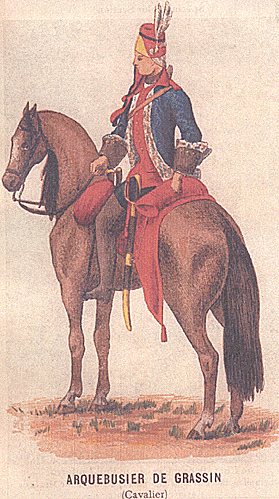 A January 1st 1744 ordinance authorized Simon Claude, Chevalier de Grassin, a captain in the Picardie regiment, to raise a corps of light troops. These would become to known as the Arquebusiers de Grassin. This grant was in return for the distinguished action and zeal Monsieur Grassin had shown as a "partisan" in the Bohemian and Bavarian campaigns.
A January 1st 1744 ordinance authorized Simon Claude, Chevalier de Grassin, a captain in the Picardie regiment, to raise a corps of light troops. These would become to known as the Arquebusiers de Grassin. This grant was in return for the distinguished action and zeal Monsieur Grassin had shown as a "partisan" in the Bohemian and Bavarian campaigns.
Formed at Metz, the corps was 1200 men strong, containing 900 fantassins (a contemporary term for "infantryman") and 300 cavaliers (cavalrymen). The cadre of this corps was provided on January 30th through the amalgamation of the compagnie franches de fusiliers de Dulimont, de Vandal, de Bayel, & de Bidache as well as the compagnies franches de dragons de Rhomberg and Bidache.
The corps was organized into nine companies of infantry (3 officers and 100 men apiece) and 6 companies of cavalry (4 officers & 50 men each). Tactically, the six cavalry companies were organized into 2 squadrons, and during a campaign the grenadiers were removed from each infantry company and pooled together to form a single grenadier company.
The composition of both types of companies was as follows:
- INFANTRY
- Officers: 1 captain and 2 lieutenants
4 sergeants, 1 fourrier, 1 capitaine d'armes, 2 cadets, 4 corporals, 4 anspessades, 2 drummers, 10 grenadiers, 72 arquebusiers
Total = 3 officers and 100 men
CAVALRY
- Officers: 1 captain, 1 lieutenant, 1 cornette, 1 marechal des logis
Men: 3 brigadiers, 1 trumpeter, 46 arquebusiers (mounted)
Total = 4 officers and 50 men
Both the colonel and the lieutenant colonel were captains of an infantry company and a cavalry company.
Uniform
Its uniform consisted of a habit with royal blue cloth bordered with white lamb skin, black cuffs, and garance red collar; a waistcoat of garance red; breeches of blue cloth; gray linen gaiters; a bonnet of red cloth with blue borders; the bonnet had a copper plaque on its front that itself had a blue and red cockade and a white plume.
The ordinance authorizing the corps' creation forbade the use of flags, guidons, or kettle drums. However, by May of that first year the corps had adopted the white flag authorized for troupes legeres in 1737 and its own unique colors.
Two permanent grenadier companies were created late the end of the year (December 25th). This was to allow the existing 9 fusilier companies to remain always at full strength without having to divest themselves of their grenadiers. These latter became fusiliers, giving each fusilier company a total of 82 arquebusiers.
In order to help replenish the severe losses the corps suffered in the du Barry woods during the battle of Fontenoy (they helped drive the English out of the woods), on May 20th 1745 the corps received an additional 200 cavalry men. This meant there were now 8 cavalry companies. Of these, the colonel and lieutenant-colonel's companies each had 100 men; the remainder only had 50 men.
On September 1st 1748 the corps was reduced to 970 men, now organized into 2 grenadier companies (50 men apiece), 7 fusilier companies (90 men each), and 6 dragoon companies (40 dragoons each).
The corps was further reduced to 640 men, now organized into 2 grenadier companies (50 men apiece), 6 fusilier companies (60 men each), and 6 dragoon companies (30 dragoons each).
The third and last reduction occurred on December 1st 1748, when along with the fusiliers de Morliere and the volontaires bretons it was limited to 340 men: 2 grenadier companies (40 men apiece), 4 fusilier companies (40 men each), and 4 dragoon companies (25 dragoons each).
The corps finally ceased to exist on August 1st 1749. On this date, it was amalgamated with the fusiliers de Morliere and the volontaires bretons to form the volontaires de Flandre.
Related:
Back to Seven Years War Asso. Journal Vol. XIII No. 1 Table of Contents
Back to Seven Years War Asso. Journal List of Issues
Back to Master Magazine List
© Copyright 2003 by James J. Mitchell
This article appears in MagWeb.com (Magazine Web) on the Internet World Wide Web.
Other articles from military history and related magazines are available at http://www.magweb.com